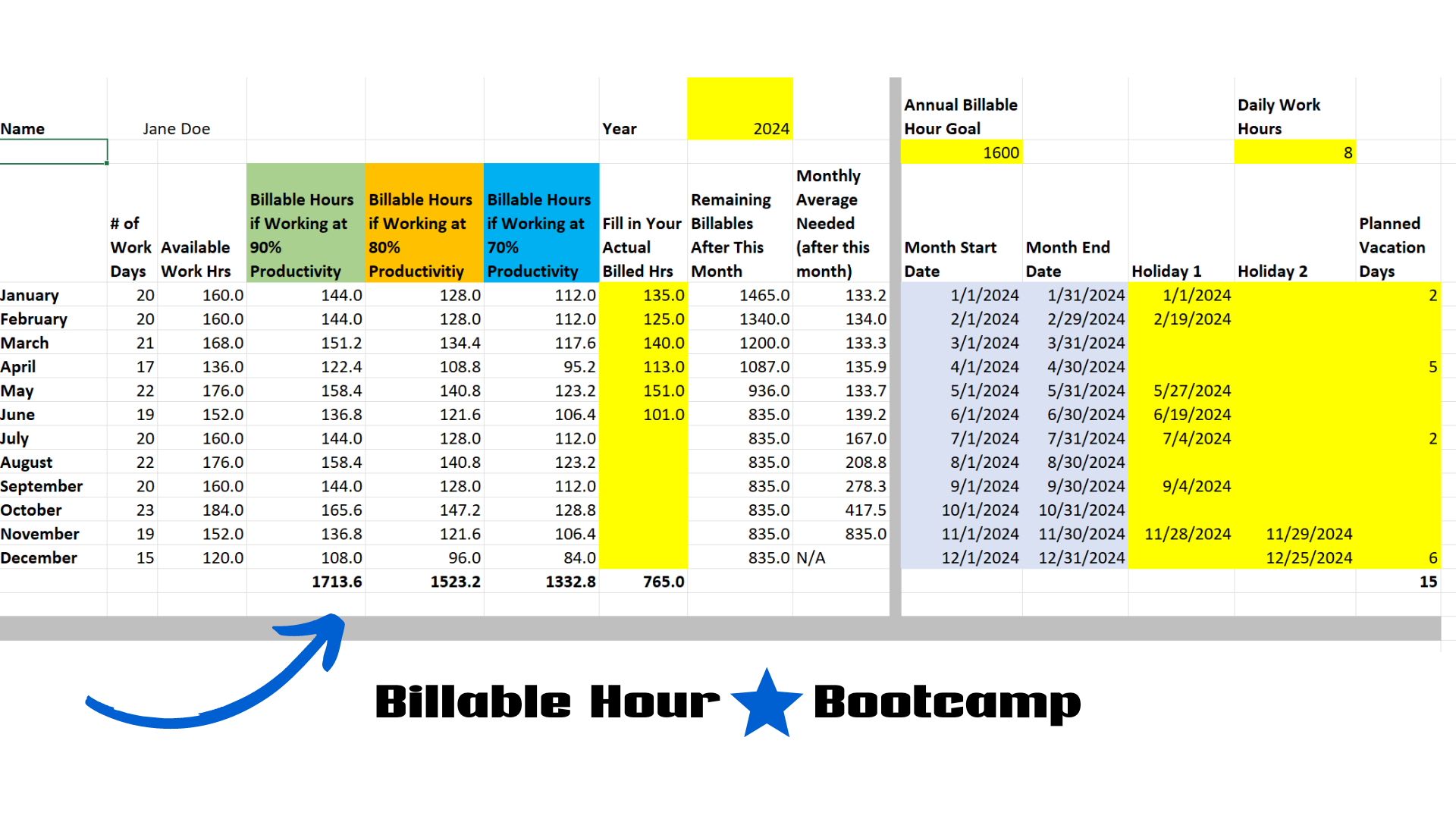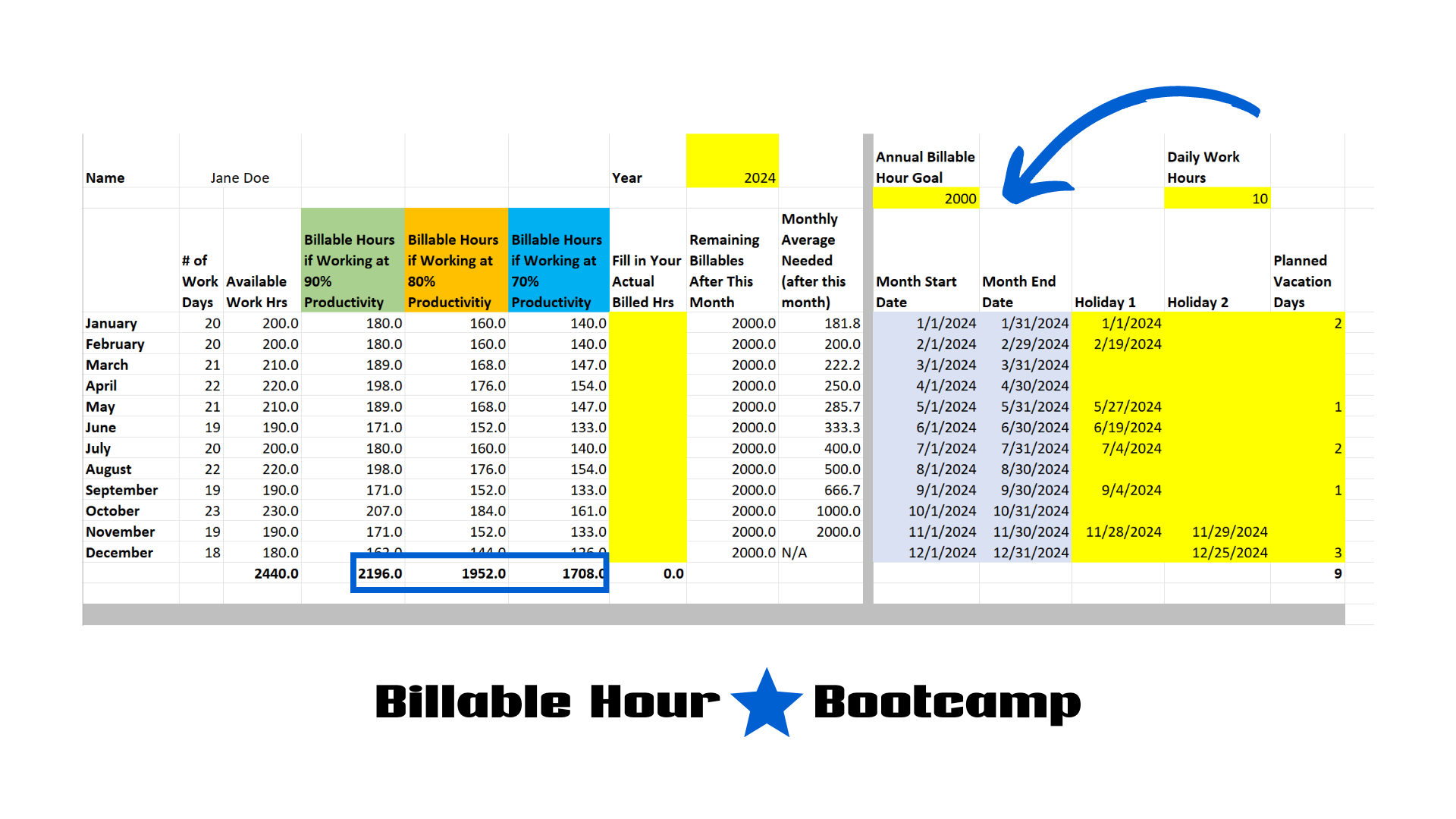
What is a Billable Hours Calculator?
A Billable Hours Calculator is a tool that helps paralegals and lawyers estimate how many billable hours in a year they can expect to achieve given the number of work hours available each month.
The calculator adjusts for various factors that affect your work hours. For instance, holidays, vacation days, and personal productivity levels can vary significantly from month to month.
I love sharing this inside the Billable Hour Boot Camp because it allows paralegals and associates to know the number of billable hours available each month, and it helps them to determine a monthly goal that is reasonable (and realistic) to hit.
Here’s a screenshot below of what a Billable Hours Calculator might look like.
The yellow highlighted cells are where the user inputs their specific data. The Billable Hours Calculator then does the rest by calculating how many available work hours are in that month and what their billable hours might look like that month depending on how productive they are that month. It also then calculates the monthly average they should shoot for based on how many billable hours they have input.

You can input your vacation days and holidays, and then see what the available billable time is if you are working at different levels of daily productivity.
What is a daily productivity percentage?
It is the percentage of your work hours that are spent on billable work. In other words, if you worked 8 hours and entered 6 hours of billable time in that day, your productivity would be 75% (6.0/8.0 =.75).
The calculator then provides an estimate of your billable hours for the month. This helps in planning and setting realistic billing targets that reflect your actual working capacity.
This tool also aids in making informed decisions about managing your workload and planning for months when you have more capacity. This can help lawyers and paralegals improve their billing practices without compromising their work quality. By using this tool, lawyers and paralegals can bill clients more effectively while maintaining high work standards.
Are you looking for ways to improve your daily productivity? Here are 3 Pro Tips for Paralegal Time Management.
How to use the calculator
The billable hours calculator picture above is a screenshot example from inside our Billable Hour Boot Camp, where we provide an Excel version of it to input a timekeeper’s specific numbers. Here’s how you can use it to estimate your available hours.
In the example above, this person has a billable hour goal of 1,600 hours per year and works 8 hours per day. That’s not always possible in a law firm, especially in certain practice areas, but I wanted to keep things simple for this example.
Notice on the right side of the spreadsheet there are areas in yellow to input the holidays and planned vacation days for the year. When that is done, the billable hour calculator automatically adjusts the total available work hours on the far left of the table.
Let’s look at January 2024 as a specific example.

In this example from 2024, the holiday is New Year’s Day. The formula in the spreadsheet knows that the date falls on a work day, plus we have 2 days we’re taking for vacation days.
Then on the far left you see based on what’s in the yellow fields, there are 20 workdays with 160 total work hours. It’s not possible for us to have 160 billable hours that month if we’re only working 8 hours per day and we’re not taking any bathroom breaks or having any personal conversations with our colleagues the entire month.
The first column in green shows that we have the capacity to bill 144 hours that month. Compare that to the blue column, which shows that we’ve only got the capacity to bill 112 hours that month if we’re working 8-hour days and billing time for 70% of our day. In other words, 30% of the day is spent on administrative or non-billable time.
Billable Time vs. Non-Billable Time
In the world of legal services, not all time spent is billable. Well, that is unless you never use the restroom or grab a cup of coffee during the day.
Understanding the distinction between billable and non-billable hours is crucial if you work for a law firm that tracks its time to invoice its clients.
Billable time is the time you can invoice to a client and directly correlates with the legal services you provide. Common examples include time spent on consultations, drafting legal documents, and court appearances.
Non-billable hours include activities that support your practice, but you do not charge clients for them. These include administrative tasks, business development efforts, and attending internal meetings. While these hours are essential for running a successful law firm, they do not generate direct revenue.
Get some quick tips on drafting time entries.
To help you determine what is billable time and what is not, ask these questions:
- Does the work provide a benefit to the client?
- Does the work move the case/transaction/file forward?
- Is the work substantive in nature?
Billable Hour Boot Camp
Live webinar series starts on September 23, 2025!
The billable hour course and coaching program to help law firm timekeepers:
✅ Exceed their annual billable targets
✅ Reduce their stress related to billable hours
✅ Write better time entries and reduce write-offs
✅ Get more work done in less time so that they have a better work/life balance
For the only time this year, we’re going live for a 5-part webinar series.
Join Ann Pearson as she gives you practical strategies, real-time coaching, and results-driven insights that you can apply immediately.
SEATS ARE LIMITED! Get yours before the doors close.

How many billable hours in a year?
To set realistic goals and expectations for the year, it’s important to know how many total billable hours are in a year. A typical full-time lawyer or paralegal might aim for about 1,800 to 2,000 billable hours per year. This number can vary a lot based on the type of practice, billing requirements, and work habits.
Instead, let’s look at the sample for real numbers.
Here is a sample below of what the Billable Hours Calculator might look like if you’re a law firm associate who has to hit 2,000 billable hours to get a bonus this year. You want to see how you can do this on only 10-hour workdays, with an occasional 3-day holiday weekend (if you’re lucky!).
What you see is that you would need to make sure you’re billing around 80% – 85% of the day if you want to hit that billable goal and still have some life outside the office.
🎯 Learn what the important numbers are to know.
Another sample from the Billable Hours Calculator

A Billable Hours Calculator can break down yearly goals into smaller monthly targets, making it easier to hit your annual target. It is also helpful in that you can plan on months when you have more capacity for billable hours so that in the lower capacity months, you’re not stressed about having a lower number. You already made up for that anticipated low month earlier in the year when you had more available hours to work.
In addition to this calculator, I also give some key strategies to change your mindset about billable hours in a recent blog post.
Conclusion
A Billable Hours Calculator is an important tool for managing your legal practice effectively. Use this calculator to plan, manage your time, and set realistic goals that align with your ambitions and abilities. This calculator can help both experienced attorneys and new paralegals advance in their careers. It can drive your career forward efficiently and effectively.
Are you new to billable hours and tracking your billable time? Here is Everything You Need to Know About Billable Hours.
Meet the Author

Ann Pearson is the Founder of the Paralegal Boot Camp, and host of the Paralegals on Fire! Podcast Show, and passionate about promoting the paralegal profession.
Ann spent 20 years working as a paralegal manager and a litigation paralegal before opening the Paralegal Boot Camp in 2010.
Ann’s training programs focus on adding immediate value to a paralegal’s career and bridging the gap between what a paralegal learns in school and what they actually do on the job.
Visit the About Us Page to learn more about why Ann started the Paralegal Boot Camp.
